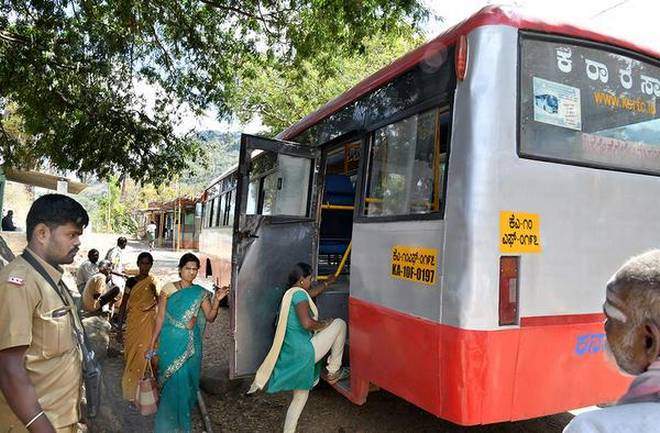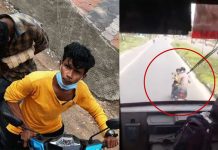Connecting Karnataka’s Kombudikki — a bus service to the outside world
As she lay uncomfortably on the makeshift stretcher — a bedsheet tied to bamboo sticks — Mahadevi knew the baby would not wait for her to reach the nearest healthcare centre, still several kilometres away. She felt every jolt as four men, her husband included, negotiated the hilly, forest terrain surrounding Doddane, a village in Chamarajanagar district of southern Karnataka.
And so, her son Likith, was born in the forest. “My wife delivering a baby in the forest is not the first such incident; we hear similar stories often,” said her husband Mahesha, as he watches Likith, now three, playing outside their house.
Lack of roads and transport has forced the residents of Doddane and the neighbouring settlements of Kombudikki and Thokere, on the eastern slopes of the Western Ghats, into relative isolation. The nearest bus stand at M.M. Hills is a good 12 km away from Kombudikki. Villagers have to undertake a longer trek to reach Doddane and Thokere, around 7 km and 5 km from Kombudikki respectively.

Flash of fame
In 2007, Kombudikki enjoyed a brief moment of fame when the then Chief Minister, H.D. Kumaraswamy, stopped over as part of his ‘Grama Vastavya’ programme. In his honour, the Karnataka State Road Transport Corporation (KSRTC) introduced a bus service from the village to the M.M. Hills depot — a single trip up and down per day. But it was discontinued in two months.
Over a decade later, a social worker, on behalf of the tribal communities, used a phone-in programme launched by the district authorities to narrate the hardships faced by villagers like Mahadevi. And someone important seems to have listened. The villagers’ request was fulfilled a few weeks ago with the KSRTC resuming the service. Today, 20 to 30 villagers use the service every day — their tenuous link to the outside world.
Crucial link
On a hot March morning, after a journey of over 130 km from Mysuru to the Male Mahadeshwara Swamy Temple (M.M. Hills), Lokesh, the conductor of a KSRTC bus, changes the route board of his bus at the main bus stand. The bus will now head through the forests to Kombudikki. A few passengers get in, greeting Lokesh cheerfully. “I walk much less now,” said Dummada Thambdi from Doddane, heading back home after a visit to the temple. “Earlier, we would walk more than 12 km from the temple to Kombudikki.” On the bus, it is a short 25-minute ride, as opposed to the two-and-a-hour trek.
Not having a road link to Doddane and Thokere has meant teachers in these remote villages often end up living in the schools or access to other basic amenities has had an impact on teachers who are teaching in these remote areas. They often end up living in their schools as returning home every day is not possible.
Harisha, a teacher at the Government Primary School in Thokere said, “I have been working here for eight years. This is the first time I am seeing a bus service till Kombudikki. Our school is located five to six km from Kombudikki. It is not possible to walk that distance everyday, so I live at the school. Once in 15 days I go home to KR Nagar in Mysuru.”
Every trip of the new service reinforces its utility, and gives KSRTC employees a sense of purpose. “This is one route where we see people anxiously waiting for a bus to turn up,” said the driver, Manu Kumar.
Can a lone service change the fortunes of a remote region? The tribal people are optimistic. Tenuous rainfed agriculture is their mainstay, and the bus could help them find jobs in nearby towns. With few opportunities, youth are often forced to leave their villages to work in quarries in Tamil Nadu and other parts of Karnataka.
Many, however, are cautious of this “good fortune,” and wonder if the service will be discontinued again. Villagers of Kombudikki feel that plight of tribals living in the area was brought to light when H.D. Kumaraswamy visited the area during his tenure as the Chief Minister. Chinnappa, whose family hosted the former CM, said, “Apart from the bus, authorities gave our hamlets a facelift. We received a lot of attention, but many issues them remained unresolved, employment being the key.”
“There is a no electricity supply to our village. We can grow foodgrains if only it rains. Protecting the crop from wild elephants and boars is also a problem,” said Puttamada of Doddane. But he then lists the advantages of life in a remote village. “We do not use fertilizers and pesticides. We rely on organic methods,” he says. With the bus service, perhaps Puttamada will be able to reach cities like Bengaluru, where consumers are ready to pay a premium for his pristine, organic produce.



















